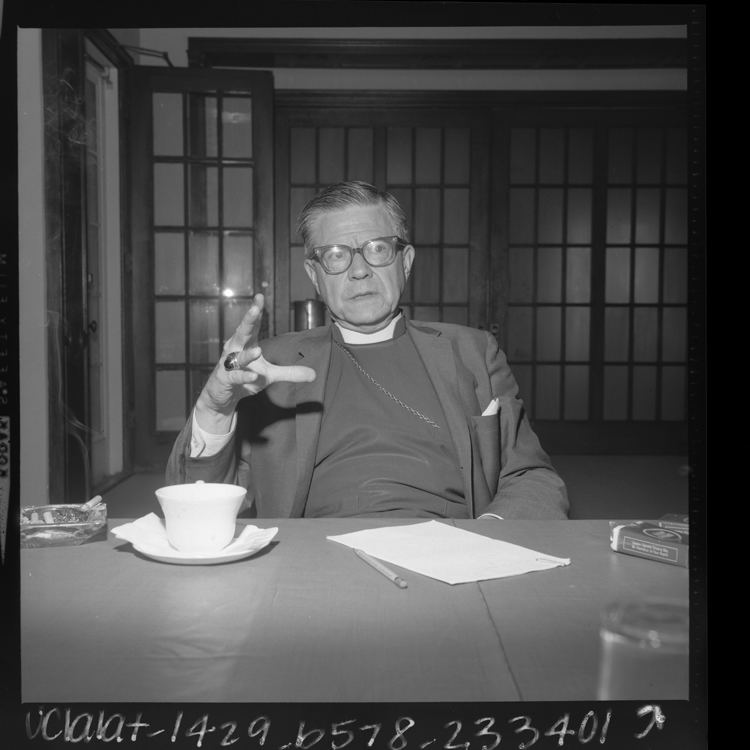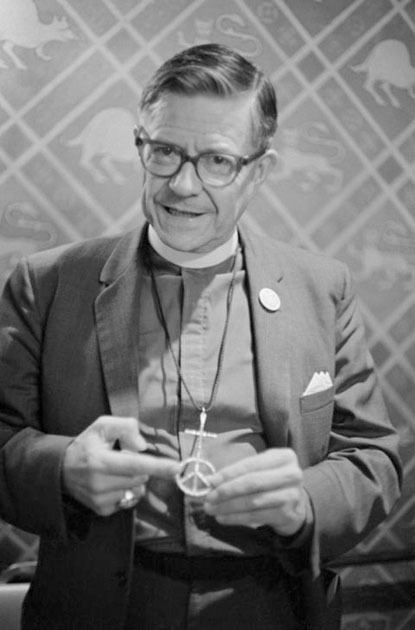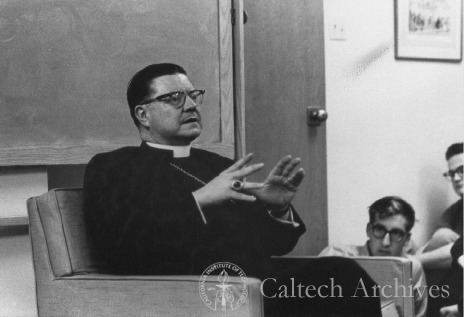See California Consecration 1958 Children Jim Pike Ordination 1946 | Role Bishop In office 1958–66 Name James Pike | |
 | ||
Predecessor Bishop Karl Morgan Block Spouse Diane Pike (m. ?–1969), Esther Yanovsky (m. ?–1969) Books The Other Side, Beyond Anxiety: The Chris, Beyond the Law: The Religious, A Roman Catholic in the White, The Faith of the Church Similar People Philip K Dick, W Norman Pittenger, Fyodor Dostoyevsky, Baruch Spinoza, Marcel Proust | ||
James pike memorial video
James Albert Pike (February 14, 1913 – c. September 3-7, 1969) was an American Episcopal bishop, prolific writer, and one of the first mainline religious figures to appear regularly on television.
Contents
- James pike memorial video
- Bishop Pike RELIGION CHURCH DOCUMENTARY
- Early life
- Conversion and early church life
- Election as bishop
- The Other Side
- Personal
- In literature
- Major works
- Biographies
- References

His outspoken, and to some, heretical views on many theological and social issues made him one of the most controversial public figures of his time. He was an early proponent of ordination of women, racial desegregation, and the acceptance of LGBT people within mainline churches. Pike was the fifth Bishop of California. Late in his life he explored psychic experimentation in an effort to contact his recently deceased son.

Bishop Pike (RELIGION CHURCH DOCUMENTARY)
Early life

Pike was born in Oklahoma City on February 14, 1913. His father died when he was two, and his mother married California attorney Claude McFadden. The young Pike was a Roman Catholic and considered the priesthood; but, while attending the University of Santa Clara, he came to consider himself an agnostic. Pike earned a doctorate from Yale Law School and married Jane Alvies. He served as an attorney in Washington, D.C., for the Securities and Exchange Commission (SEC) during Franklin D. Roosevelt's New Deal era and taught Law at George Washington University. In World War II, he served with Naval Intelligence.
Conversion and early church life

After World War II, Pike and his second wife joined the Episcopal Church. He first entered Virginia Theological Seminary and then Union Theological Seminary, to prepare for the priesthood. He was ordained in 1946, first serving as an assistant at St. John's, Lafayette Square in Washington, D.C., then as Rector of Christ Church in Poughkeepsie, New York. He next became head of the Department of Religion and chaplain at Columbia University. He left Columbia in 1952 to become the Dean of the Cathedral of St. John the Divine, New York. Using his new position and media savvy, he vociferously opposed the local Catholic bishops over their attacks on Planned Parenthood and their opposition to birth control. He accepted an invitation to receive an honorary doctorate from Sewanee: The University of the South in Tennessee, but then publicly declined after finding that the university did not admit African Americans. An example of Pike's use of the media is how he released his letter to the New York Times before it was delivered to Sewanee's trustees: they heard the news when reporters called for reactions. It was also at this time that he publicly challenged Senator Joseph McCarthy's allegation that 7,000 U.S. pastors were part of a Kremlin conspiracy; when the newly elected President Dwight D. Eisenhower backed up Pike, McCarthy and his movement began to lose their influence.
In New York, Pike reached a large audience with liberal sermons and weekly television programs. Common topics included birth control, abortion laws, racism, capital punishment, apartheid, antisemitism, and farm worker exploitation.
Election as bishop
Pike was elected as bishop coadjutor of California in 1958 and succeeded to the See a few months later, following the death of his predecessor, Karl Morgan Block. He served in this position until 1966, when he resigned, to work for the Center for the Study of Democratic Institutions, a liberal, private-sector think tank.
His episcopate was marked by both professional and personal controversy. He was one of the leaders of the Protestants and Other Americans United for the Separation of Church and State movement, which advocated against John Kennedy's presidential campaign because of Catholic teachings. While at Grace Cathedral, he was involved with promoting a living wage for workers in San Francisco, the acceptance of LGBT people in the church, and civil rights. He also recognized a Methodist minister as having dual ordination and freedom to serve in the diocese. Later, he ordained a woman as a first-order deacon, now known as a "transitional deacon", usually the first step in the process towards ordination in the priesthood in the Episcopal church. The ordination was not approved until after Pike's death.
Among his notable accomplishments, Pike invited Dr. Martin Luther King, Jr. to speak at Grace Cathedral in San Francisco in 1965 following his march to Selma, Alabama.
Pike's theology involved the rejection of central Christian beliefs. His writings questioned a number of widely accepted beliefs, including the virginityof Mary, the Mother of Jesus, the doctrine of Hell, and the Trinity. He famously called for "fewer beliefs, more belief." Heresy procedures were begun in 1962, 1964, 1965, and 1966, each growing in intensity, but in the end the Church decided it was not in the denomination's best interest to pursue an actual heresy trial.
In his personal life, Pike had been a chain-smoker and an alcoholic. His charismatic personality drew many people to him, including Maren Hackett Bergrud, with whom he developed a romantic relationship after the failure of his second marriage in 1965.
The Other Side
In 1966, Pike's son Jim took his own life in a New York City hotel room. Shortly after his son's death, Pike reported experiencing poltergeist phenomena—books vanishing and reappearing, safety pins open and indicating the approximate hour of his son's death, half the clothes in a closet disarranged and heaped up. Pike led a public pursuit of various spiritualist and clairvoyant methods of contacting his deceased son to reconcile. In September 1967, Pike participated in a televised séance with his dead son through the medium Arthur Ford, an ordained minister in the Disciples of Christ church. Pike detailed these experiences in his book The Other Side.
Personal
Pike's first marriage was in 1940; he had it annulled in 1941. He married Esther Yanovsky in 1942; she filed for divorce from Pike in 1965 (finalized in 1966). They had two children, a boy and a girl. He lived with, but did not marry, his secretary Maren Bergrud, until 1967, when she committed suicide after they had an argument (he performed the funeral for her in his church). In 1968 he married Diane Kennedy (born 1938), with whom he had collaborated on a book detailing his experience with spiritualism.
In August 1969, Pike and Diane traveled to Israel, to perform research for a proposed book. On 2 September they drove into the Judean Desert. In preparation for a book on the historical Jesus, they wanted to have a feeling for why Jesus would have gone out into that wilderness to fast and meditate for 40 days. They were unprepared for the journey, having taken along only two Cokes and no water. When their rented car became stuck in a deep rut, the two were not able to extract it (neither knew how to use the car's jack). After an hour of stressful efforts to get the car to move, they decided to walk toward Qumran, where they knew there would be water. What they did not know was that they were far south of Qumran in Wadi Mashash. After two hours of walking in the very hot sun, Pike felt he had to rest. Diane was concerned that, without water, they would both die there so she determined to walk on to find help. After ten long hours of climbing on the walls of the canyon and stumbling along a road under construction, she came upon a camp of Arab laborers. They gave her tea to drink until the foreman came and took her to the nearest army camp. It took four days to find Pike’s body. He had tried to follow his wife and had fallen more than 60 feet down a steep canyon wall where he died. The probable date of his death is 2 September; some sources cite it as between 3 and 7 September. He was buried in the Protestant Cemetery in Jaffa, Israel, on 8 September 1969.
